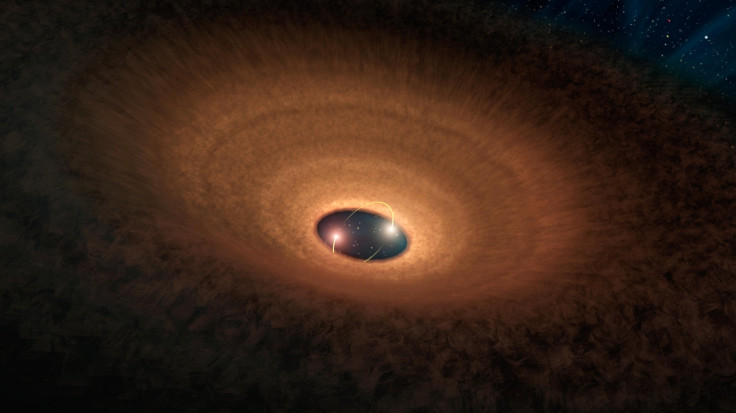NASA’s Spitzer Space Telescope Observes A Stellar System That Has Its Own 'Hula Hoop' Dust Disk
NASA’s Spitzer Space Telescope discovered a stellar system in its infancy and observed some rather interesting phenomena. Of the three young stars that make up the system, two of them have a leftover dust disk surrounding them that resembles a "hula hoop."

The stellar system, YLW 16A, is located in the Rho Ophiuchi cloud complex, a star-forming region consisting of dense gas and dust, 407 light-years from earth. The dust disk is at a tilt due to the gravitational pull of the third star in the system.
The system goes through bright and dim periods, resembling a blink, every 93 days, NASA says. As the two stars orbit one another, they eventually appear above the dust disk, creating a period of brightness but will eventually be obscured by the surrounding dust. The observations of YLW 16A were made by NASA’s Spitzer Telescope in infrared light. Other observations came from the Two Micron All-Sky, or 2MASS, Survey at the Infrared Processing and Analysis Center at the California Institute of Technology and the European Southern Observatory’s Very Large Telescope in Chile.
Blinking stellar systems similar to YLW 16A were believed to be relatively rare but recent observations indicate these systems may be more common. NASA notes the discovery of four other blinking stellar systems. Lead author Peter Plavchan, from the NASA Exoplanet Science Institute and IPEC at Caltech, said, “These blinking systems offer natural probes of the binary and circumbinary planet formation process.” Binary planets are those that orbit a single star while circumbinary planets orbit two stars. Plavchan’s research will be published in the journal Astronomy & Astrophysics.
The dust disk surrounding the stars will eventually be the fuel for the formation of other stars and planets to form a new solar system, NASA says. Future observations of blinking stellar systems could provide new insight on planet formations as well as the dust and other material that make up the disks.
© Copyright IBTimes 2024. All rights reserved.






















